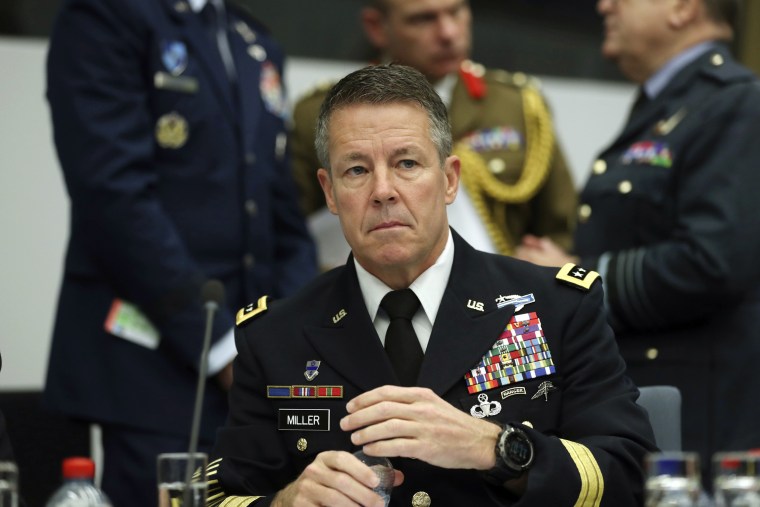KABUL, Afghanistan — The commander of U.S. and NATO troops in Afghanistan stepped down Monday afternoon, nearly three years after he took over the war.
In a transfer of authority ceremony at Resolute Support Headquarters in Kabul Monday afternoon, Army Gen. Austin “Scott” Miller said, “The people of Afghanistan will be in my heart and on my mind for the rest of my life.” He called the post “the highlight of my military career.”
“Our job now is not to forget” those who sacrificed here, he said.

Miller, who took command in 2018, led U.S. forces longer than any of his predecessors, and he was at the helm when President Joe Biden announced that all U.S. troops would leave by Sept. 11, 2021. Monday’s ceremony and Miller’s departure mark the symbolic end to the U.S. military mission in Afghanistan, nearly 20 years after it began.
Marine Corps Gen. Frank McKenzie, the commander of U.S. Central Command, formally took over responsibility for U.S. Forces Afghanistan at the ceremony. He paid tribute to Miller, calling him “the right leader at the right time” and said he did “an exceptional job.”
McKenzie told Afghan forces, “You can count on our support in the dangerous and difficult days ahead.”
Prior to Monday’s ceremony, McKenzie already had ultimate authority over the U.S. mission in Afghanistan as the commanding general of all U.S. forces in this region.
Speaking on the plane on the way to Kabul, McKenzie called the ceremony “a visible symbol of the change of responsibility” and said that it shows the Afghans that the U.S. is still going to support them. McKenzie acknowledged that support will be very different in the future.
In the past the U.S. military has backed up the Afghan military’s fight against the Taliban with airstrikes. The U.S. drawdown has proceeded much faster than announced. The U.S. had 2,500 to 3,500 troops deployed here when Biden announced the decision, but more than 90 percent of the U.S. personnel and equipment had left by the beginning of July. The U.S. is on track to have all U.S. troops and equipment out of Afghanistan before the end of the month.
As the U.S. military has departed, however, the Taliban have taken over more territory all around the country, creating concern that the weak Afghan central government could fall once the U.S. and NATO troops are completely gone.
To reassure the Afghan government and attempt to hold off a Taliban advance, the Biden administration announced that the U.S. military would not officially leave until Aug. 31. The U.S. will keep about 650 troops in Kabul for embassy security and several hundred more to help with security at Hamid Karzai International Airport. The announcement also gave contractors several more weeks in the country to work with the Afghan military.
When the U.S. military mission in Afghanistan officially ends on Aug, 31, U.S. airstrikes against the Taliban will likely end, too.
“From now until the end of August as we finish our drawdown we will be ready to conduct [counterterror] strikes as necessary against al Qaeda and ISIS targets, should they emerge and pose a threat to the United States. At the same time we will also support Afghan forces,” McKenzie said. “After the end of August we will be prepared to strike [counterterror] targets and al Qaeda targets only.”
The decision about when and where to carry out airstrikes still rests with McKenzie, as it did when Miller was in charge. “I am ultimately responsible for it like I was ultimately responsible for it before. So there’s no particular change there,” McKenzie said on the plane.
McKenzie pointed out that the Afghan Air Force has been operating more independently, shouldering much of the responsibility for strikes.
“Over the last 3 days we’ve done one strike against the Taliban,” he said, while the Afghan Air Force carried out 14 strikes against the Taliban in just one day.
